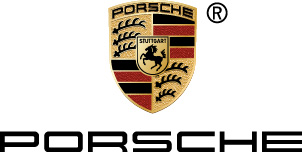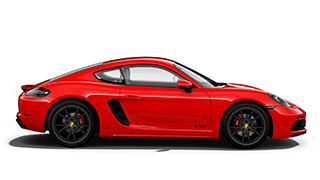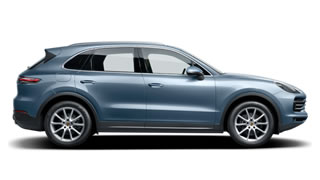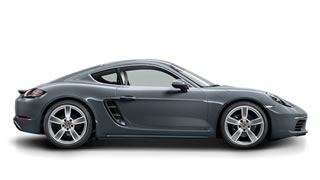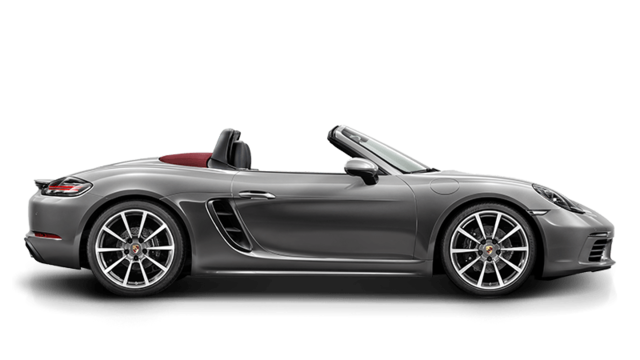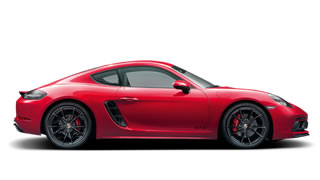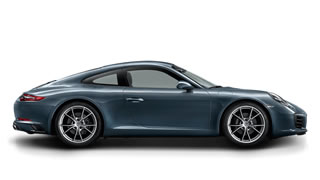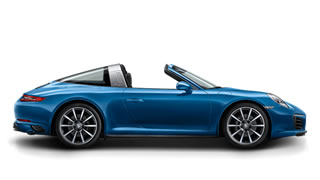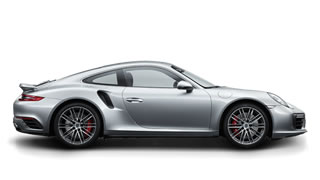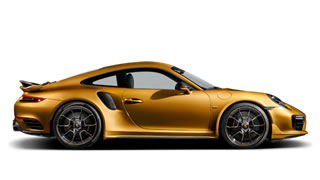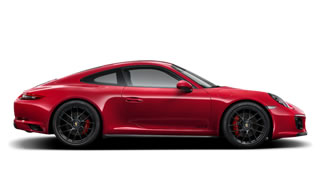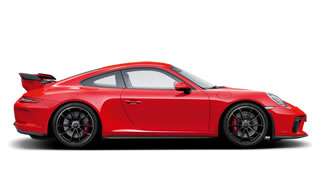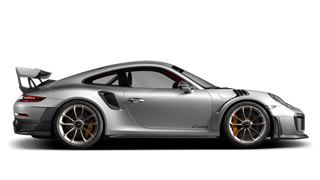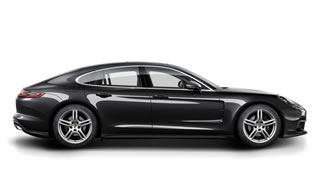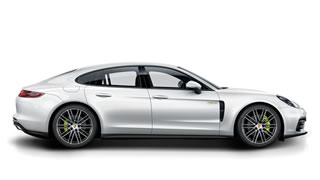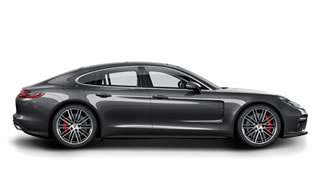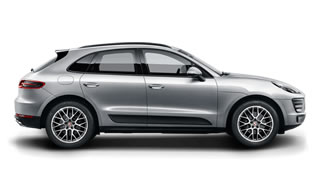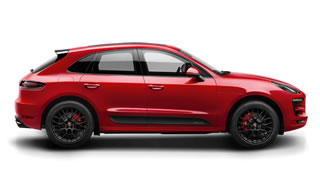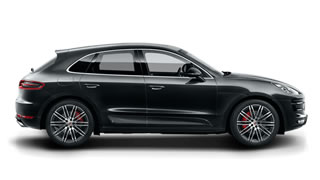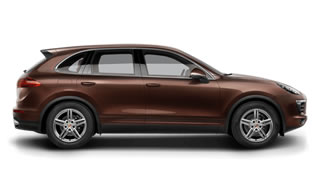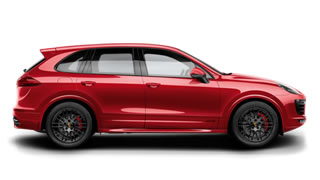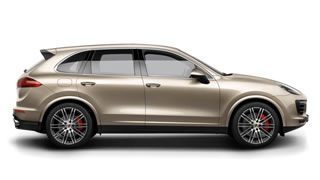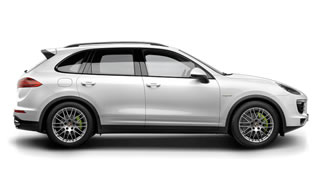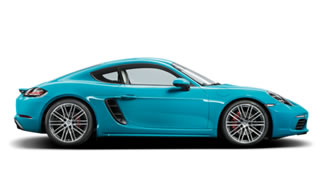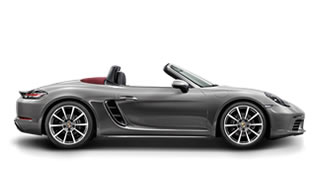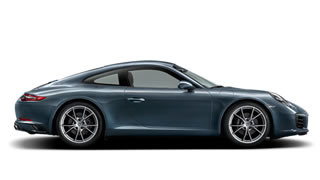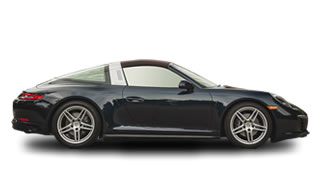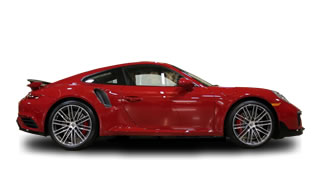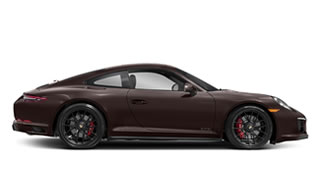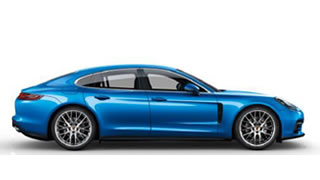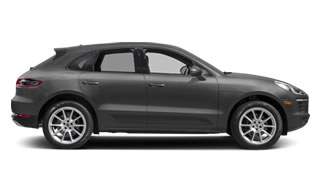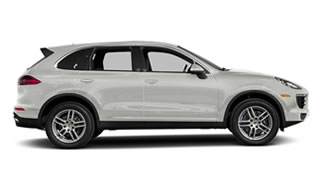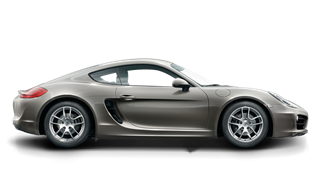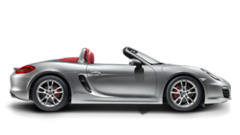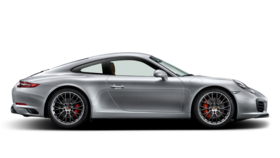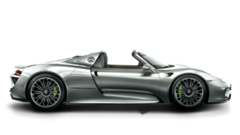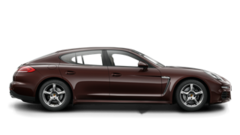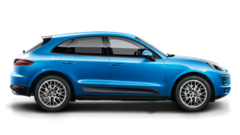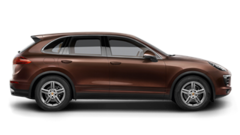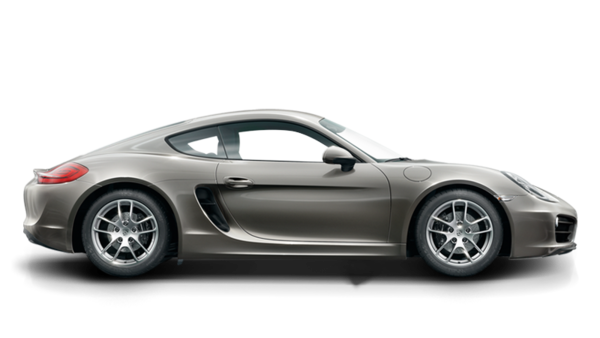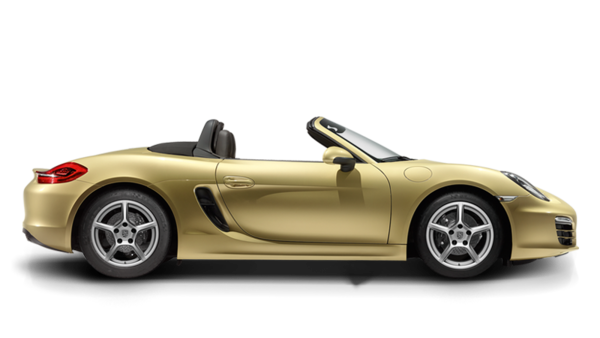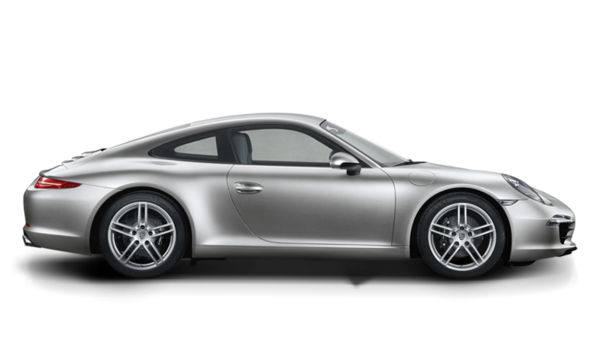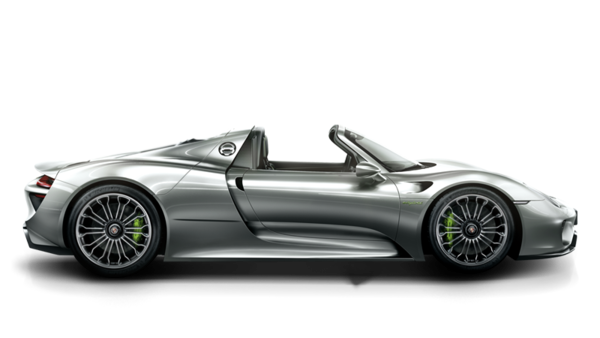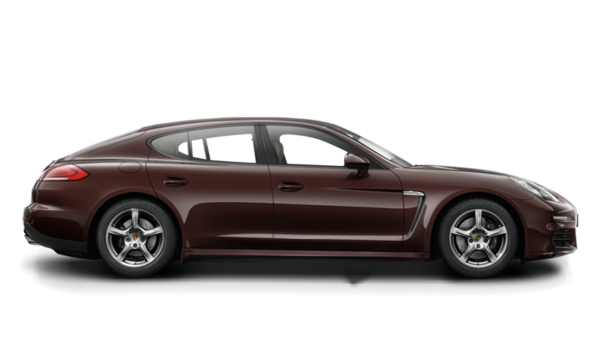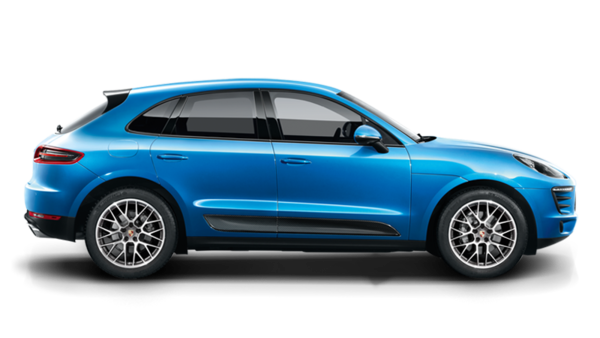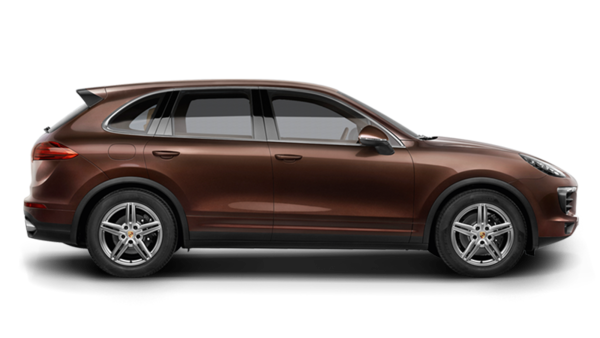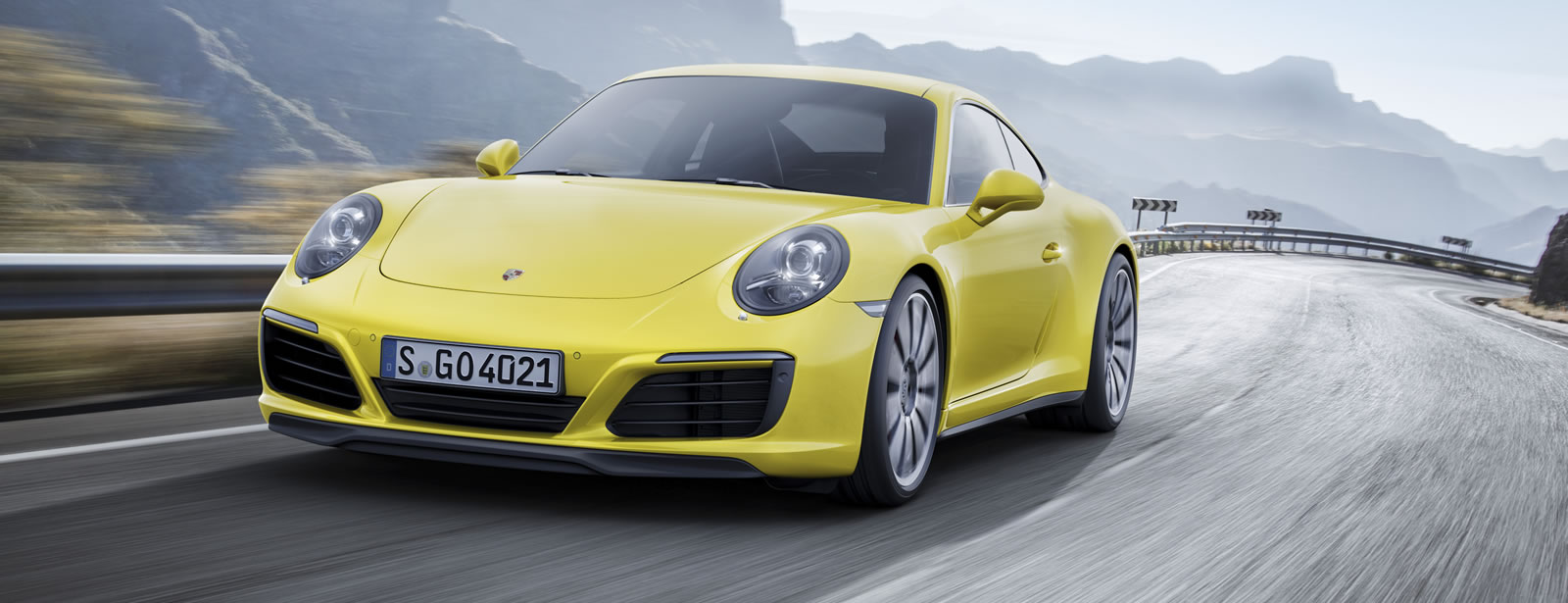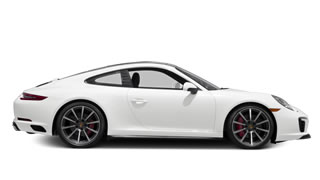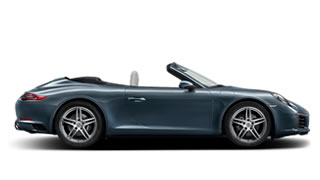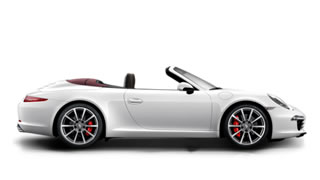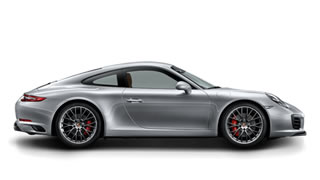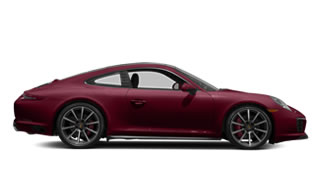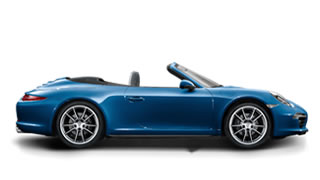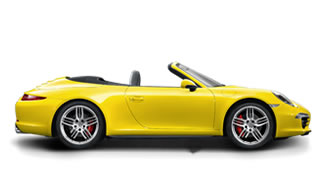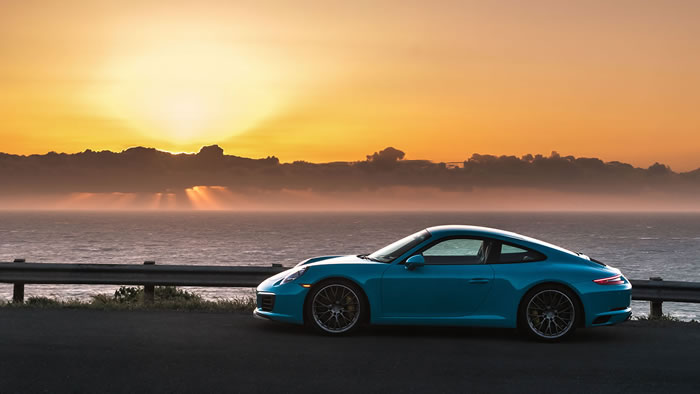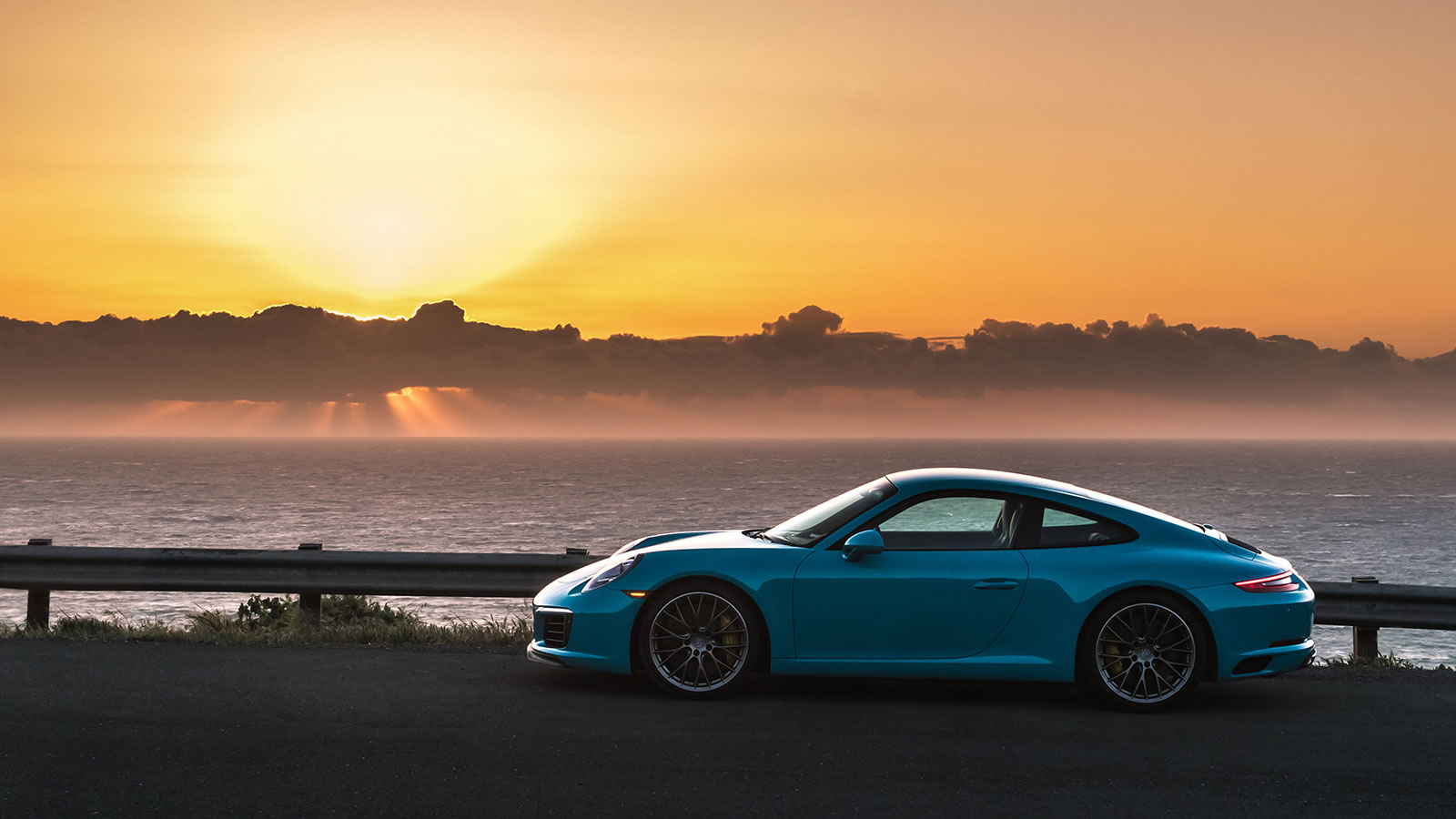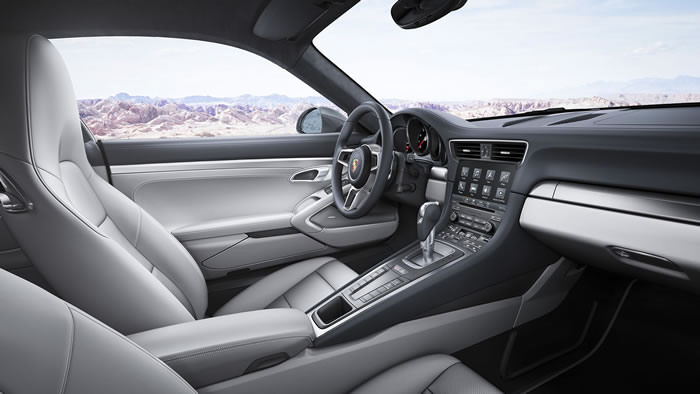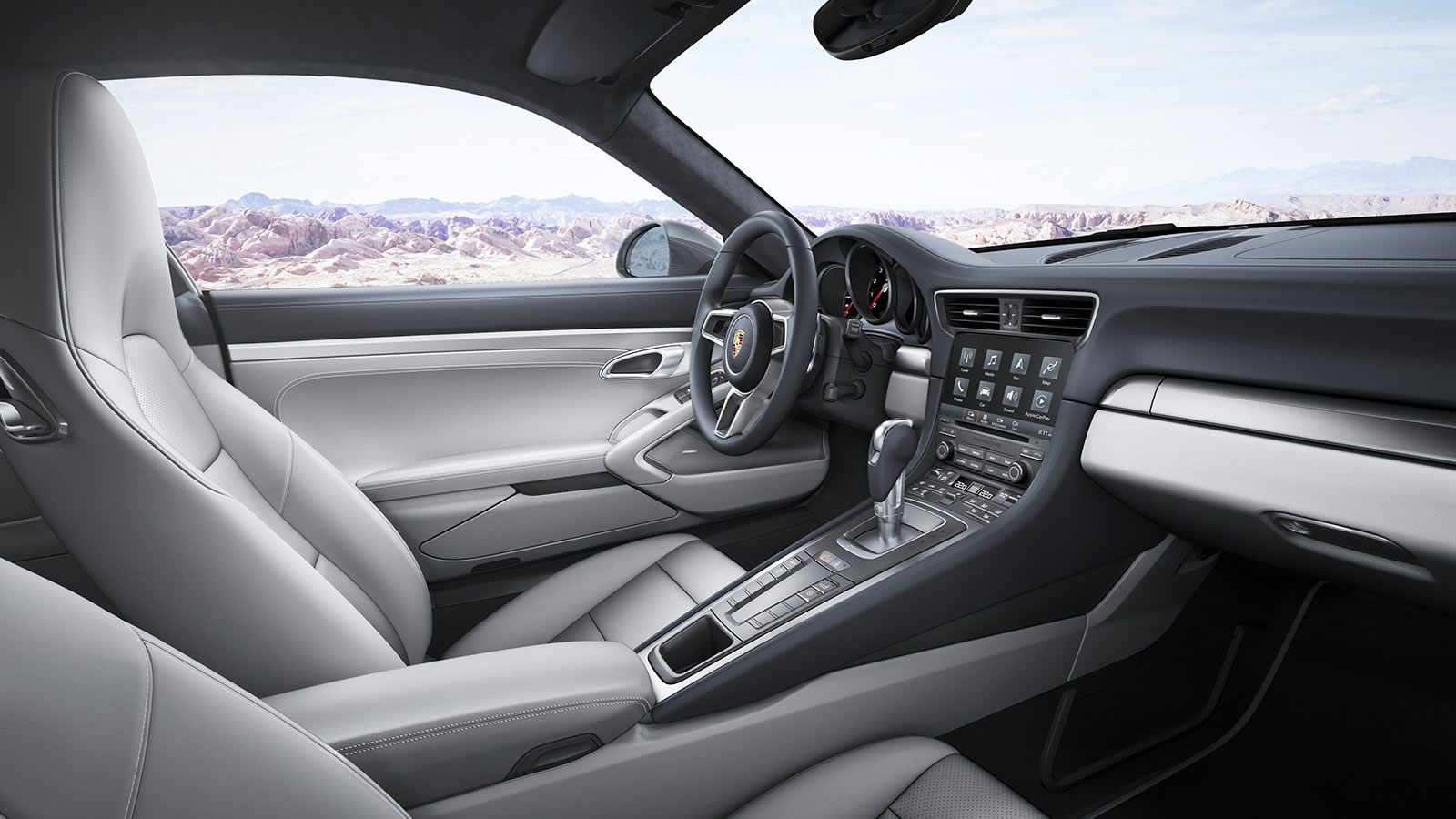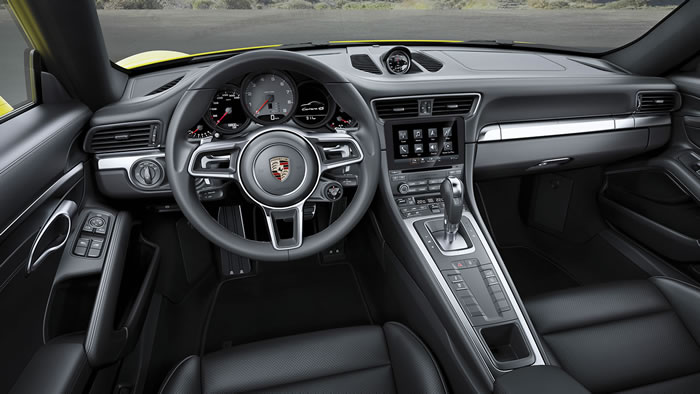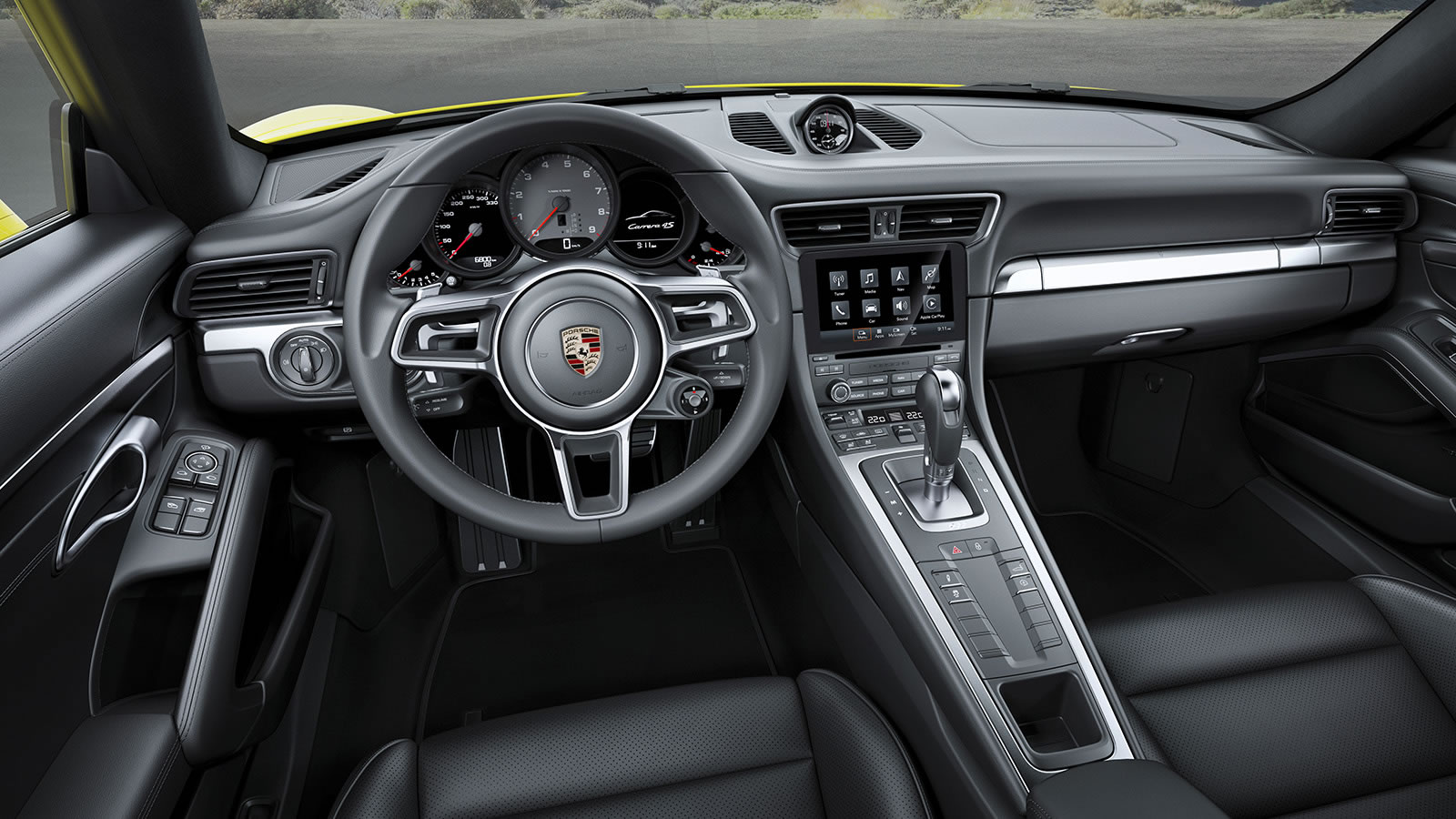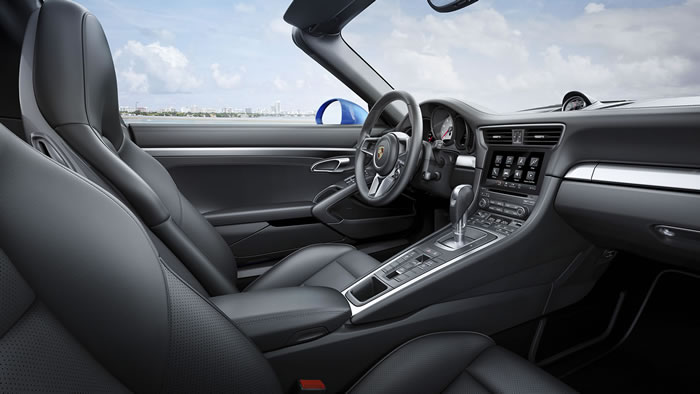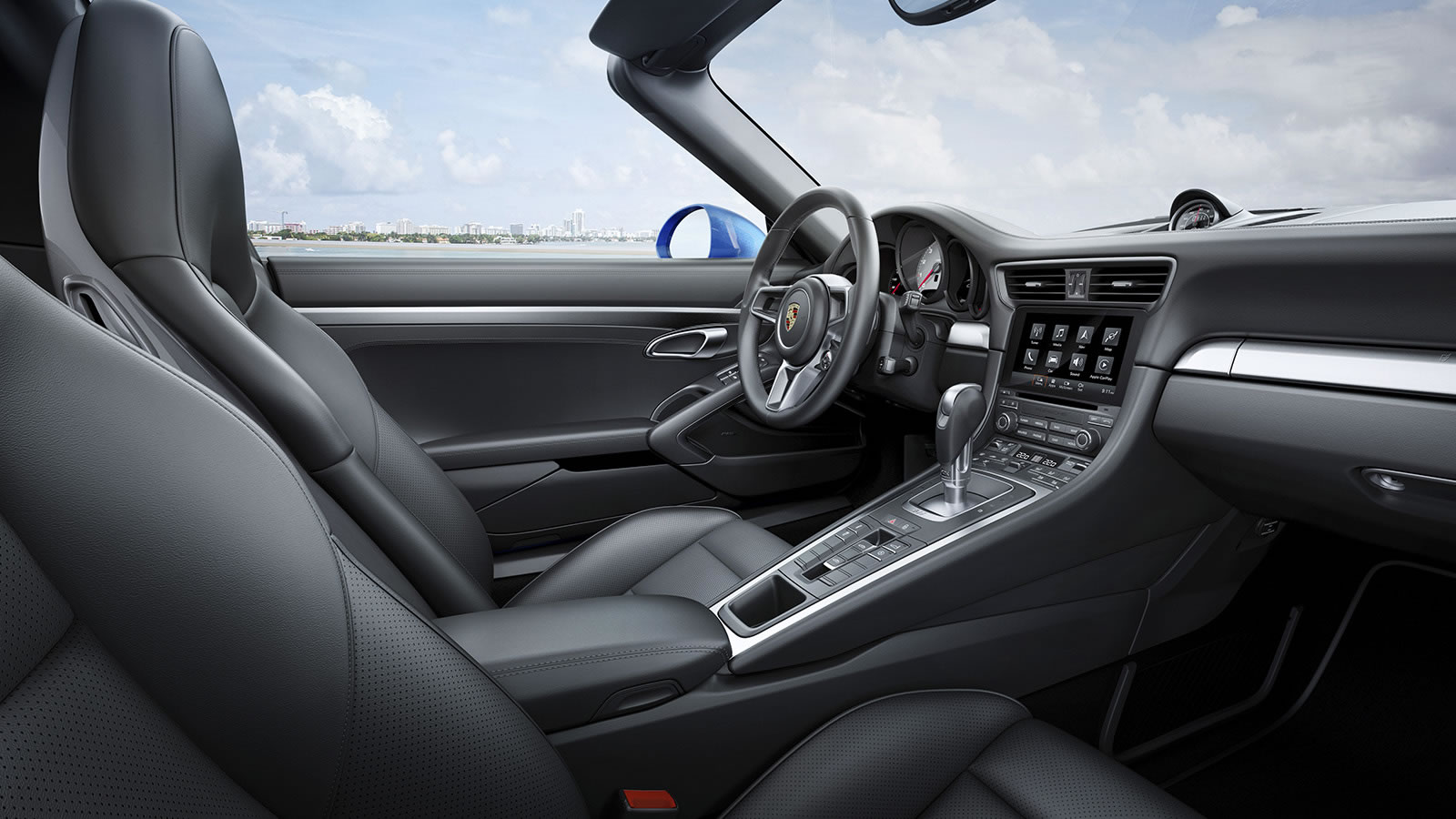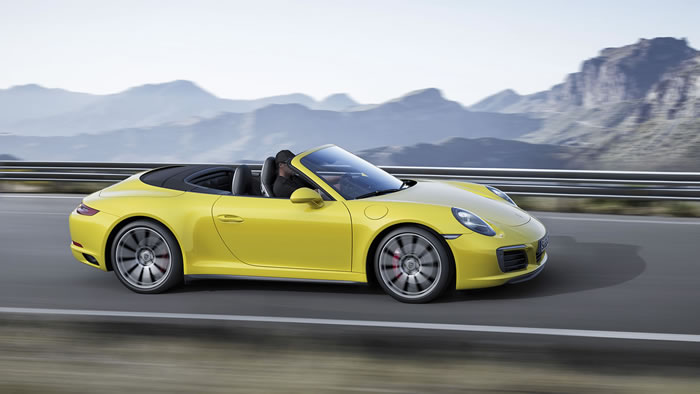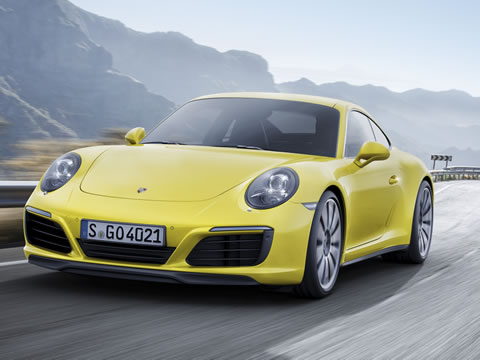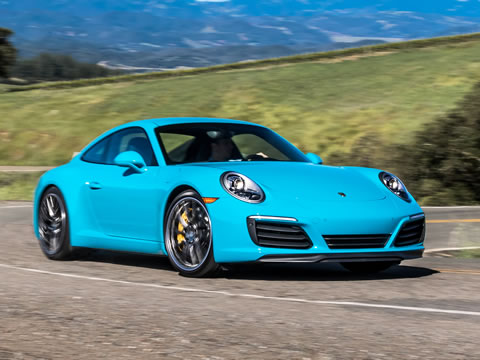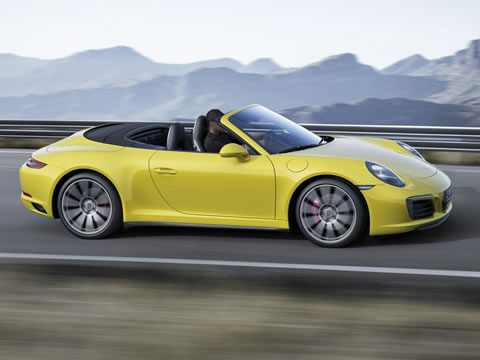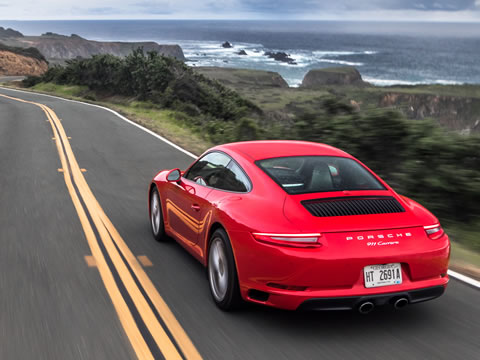Porsche Riverside
8423 Indiana Ave. Riverside, CA 925042017 Porsche 911 Carrera OVERVIEW 
2017 Porsche 911 Carrera in Riverside
Porsche 911 Carrera Dealer in Riverside
2017 Porsche 911 Carrera Gallery 
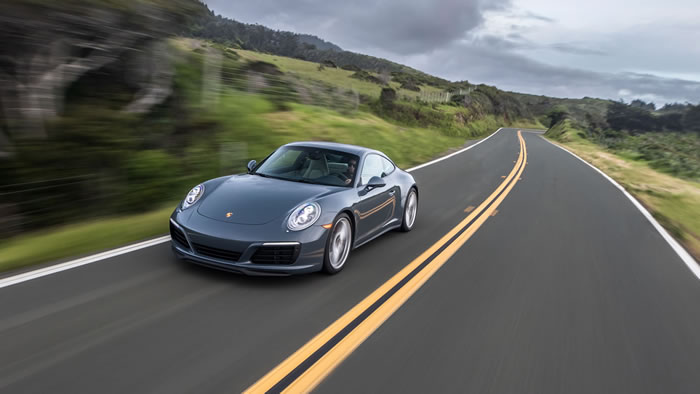

2017 Porsche 911 Carrera 4S
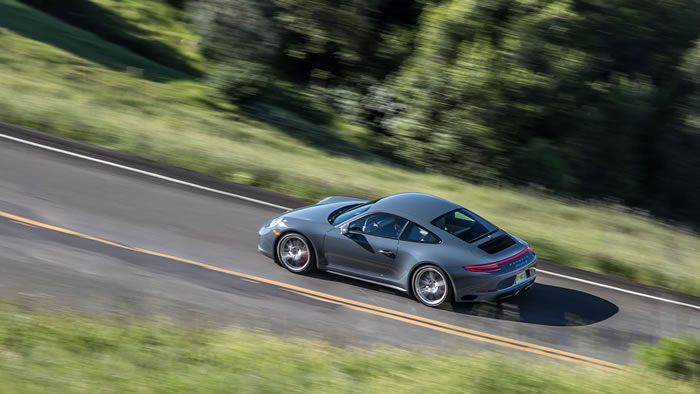
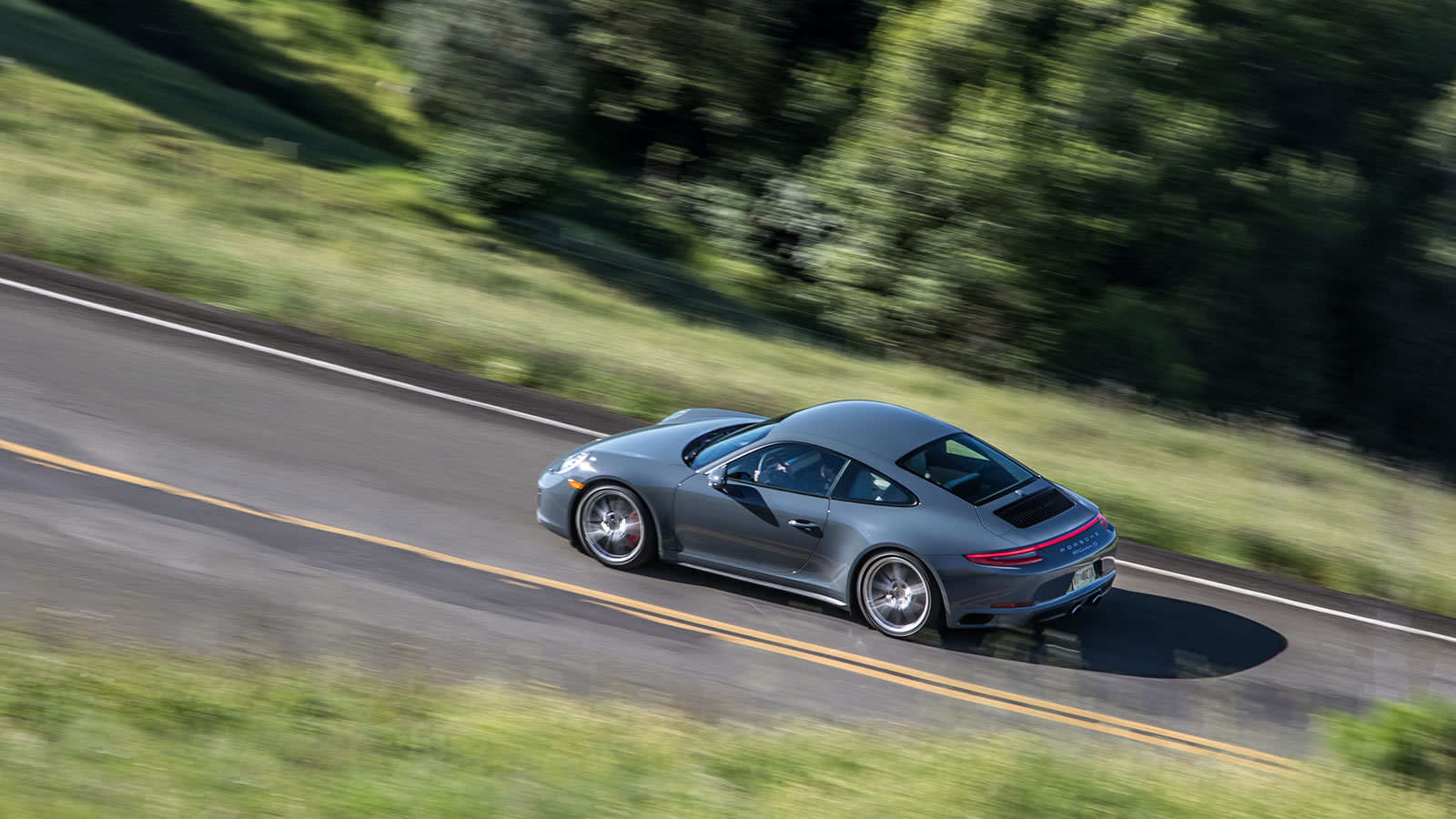
2017 Porsche 911 Carrera 4S

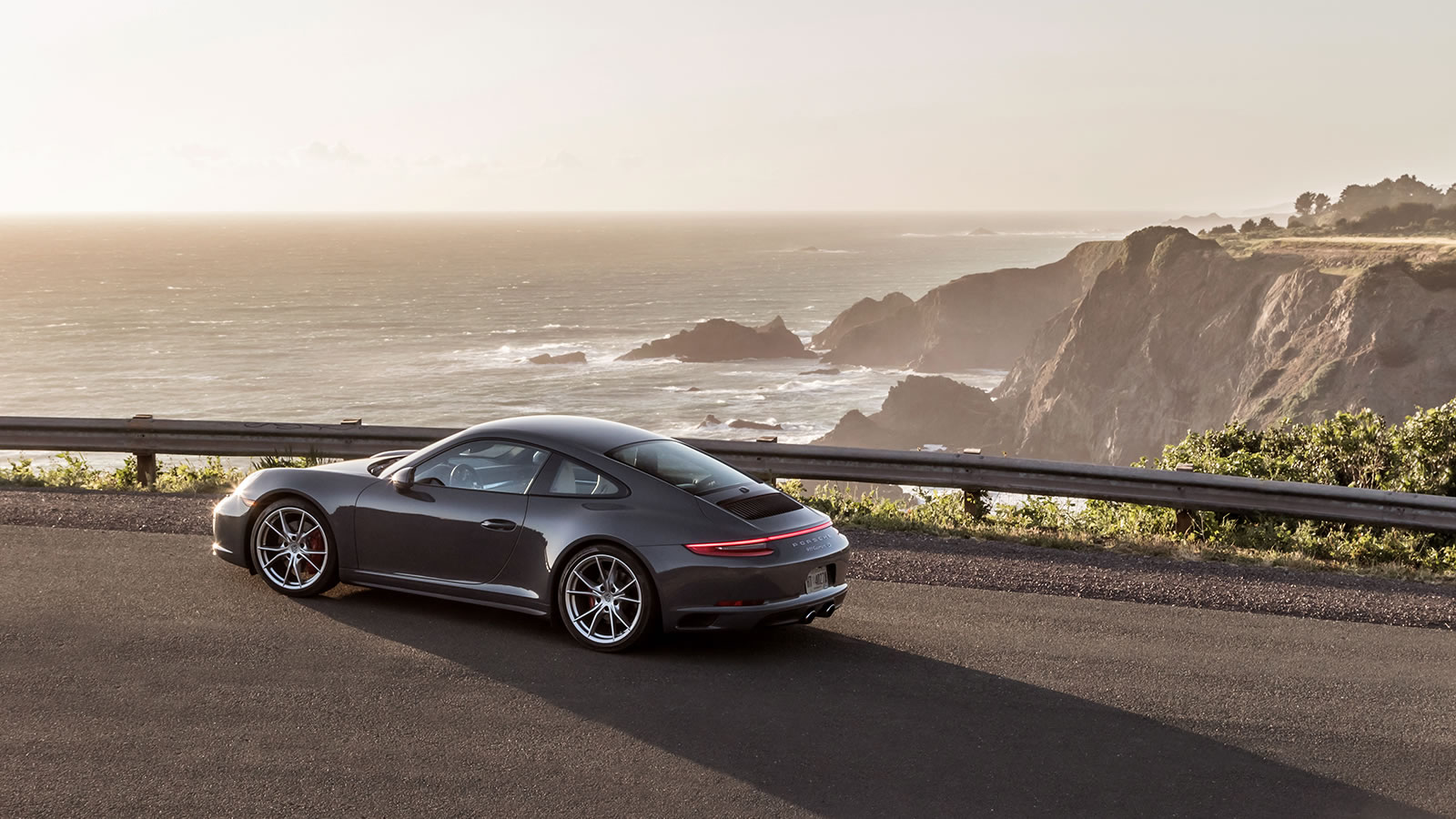
2017 Porsche 911 Carrera 4S

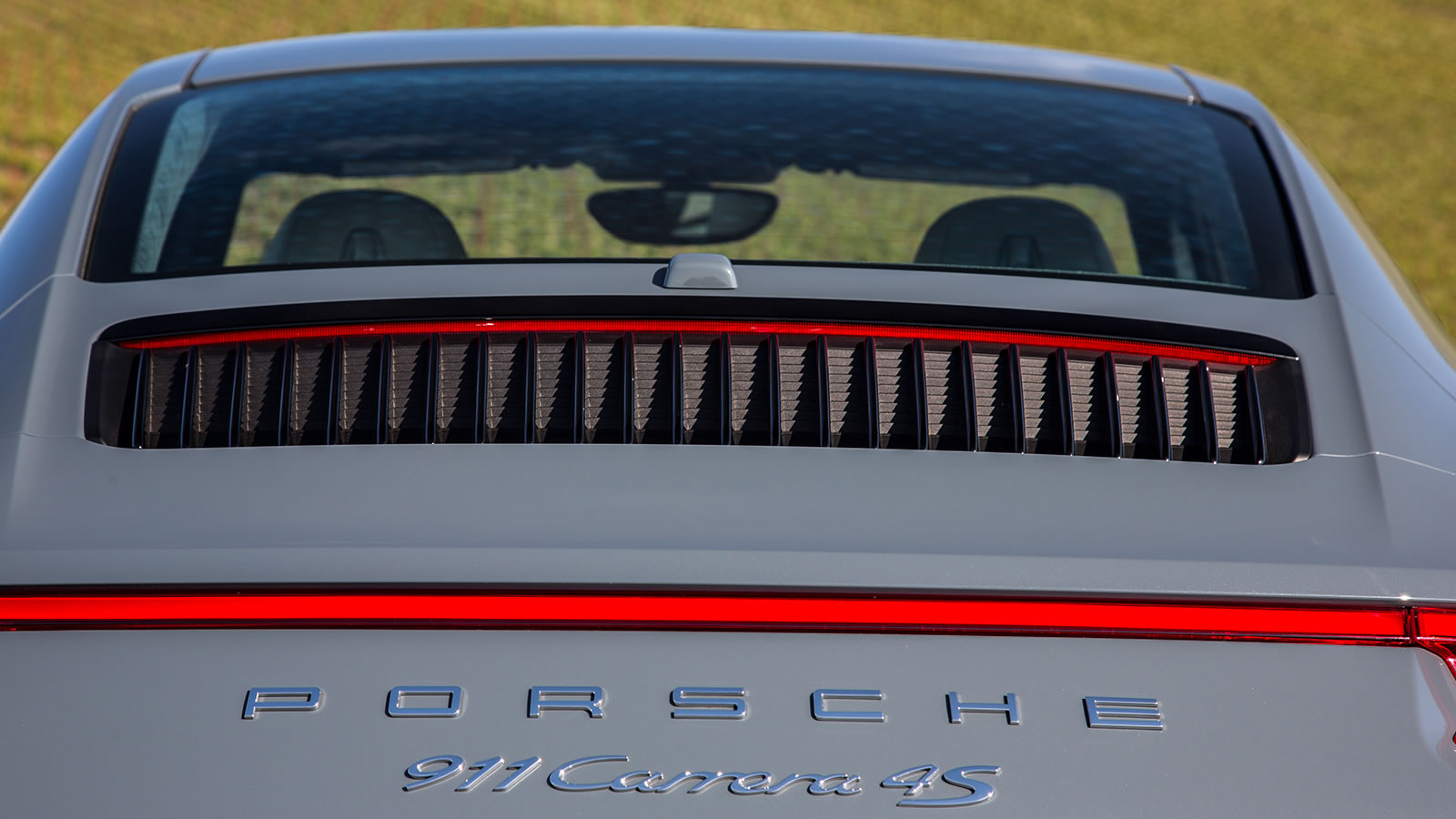
2017 Porsche 911 Carrera 4S
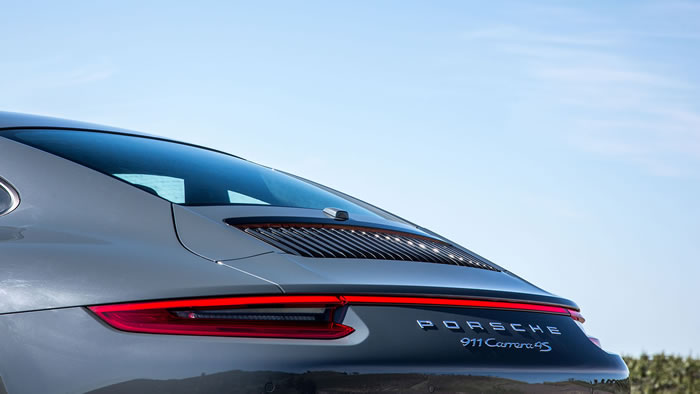

2017 Porsche 911 Carrera 4S
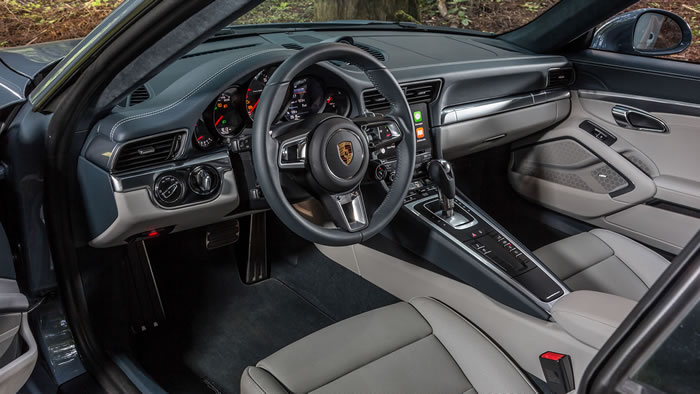

2017 Porsche 911 Carrera 4S

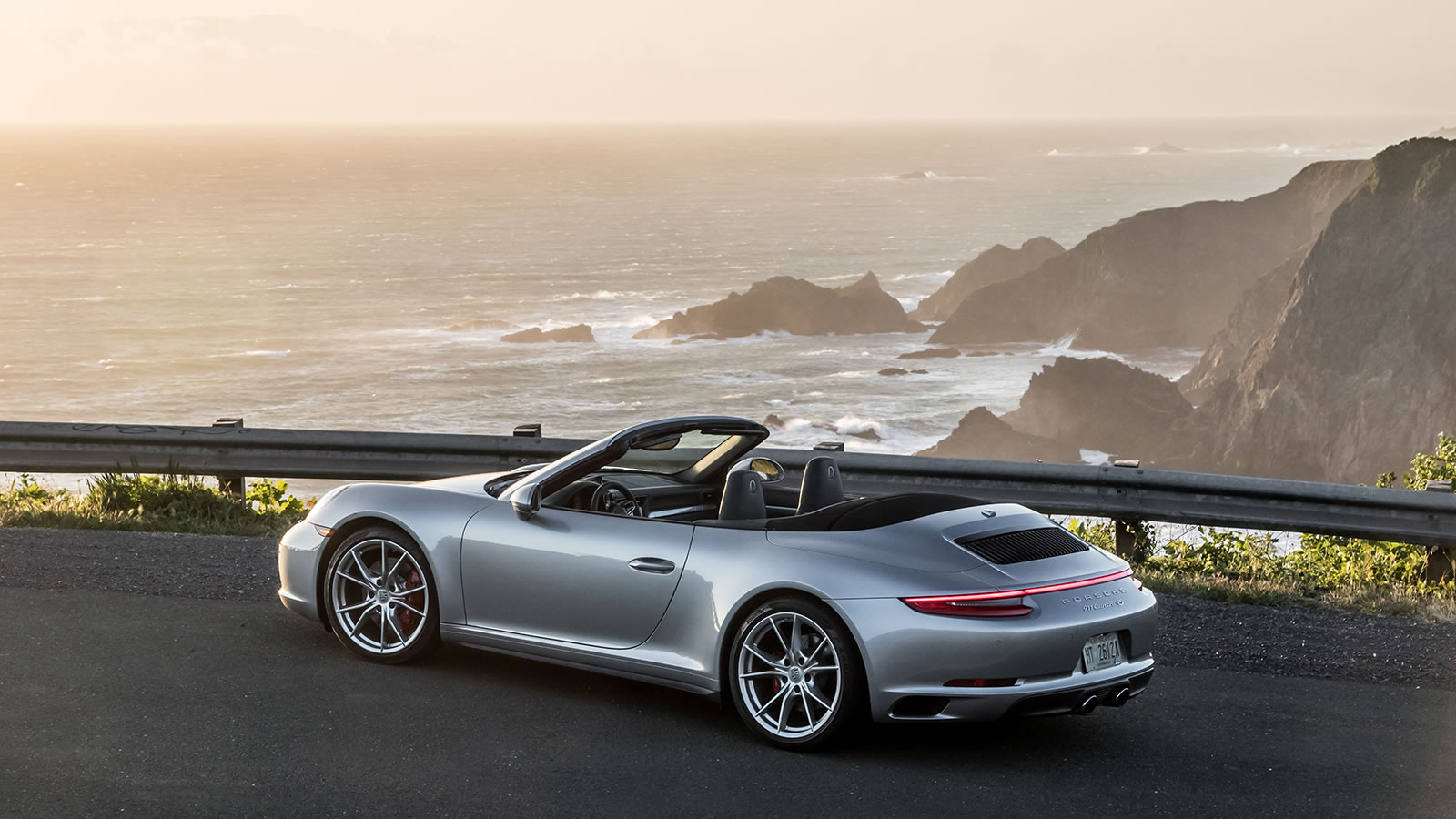
2017 Porsche 911 Carrera 4S Cabriolet
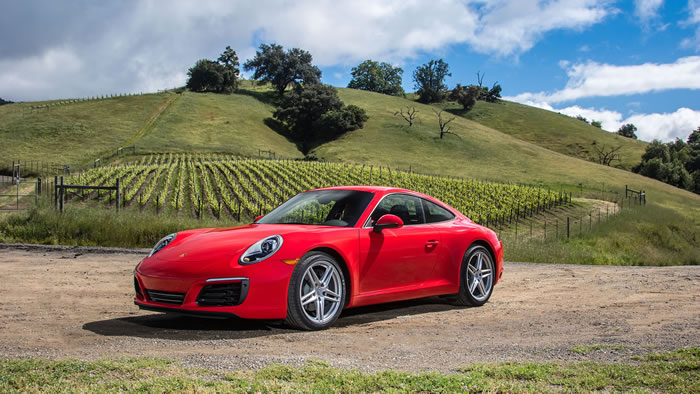
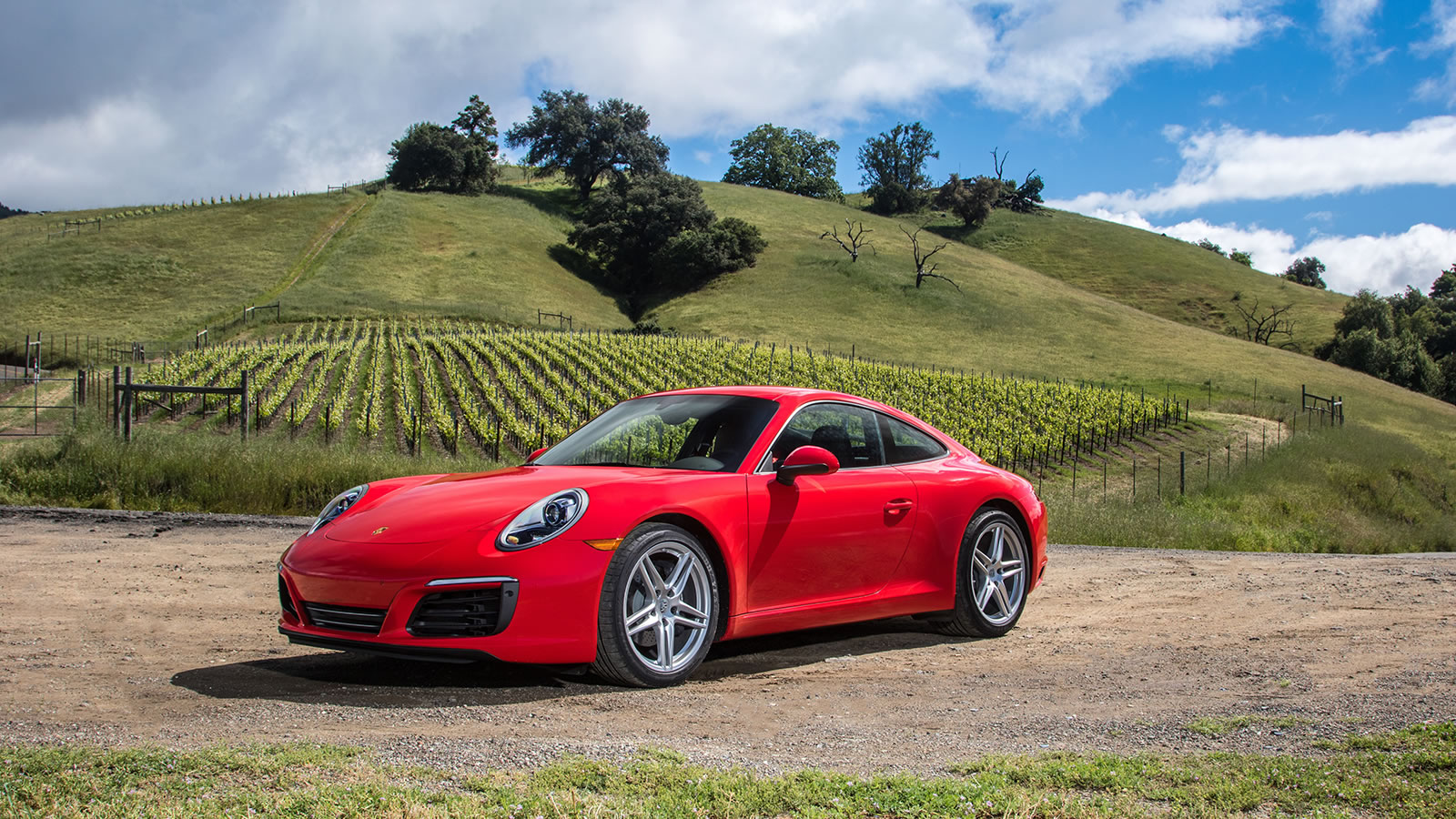
2017 Porsche 911 Carrera
2017 911 Carrera Specifications 
| 911 Carrera | 911 Carrera S | 911 Carrera Cabriolet | 911 Carrera S Cabriolet | |
|---|---|---|---|---|
| Engine | ||||
| Engine layout | Rear Engine | Rear Engine | Rear Engine | Rear Engine |
| Engine type | Boxer, twin-turbo | Boxer, twin-turbo | Boxer, twin-turbo | Boxer, twin-turbo |
| Cylinders | 6 | 6 | 6 | 6 |
| Valves per cylinder | 4 | 4 | 4 | 4 |
| Construction | Aluminum crankcase and heads | Aluminum crankcase and heads | Aluminum crankcase and heads | Aluminum crankcase and heads |
| Fuel injection | Direct Fuel Injection (DFI) | Direct Fuel Injection (DFI) | Direct Fuel Injection (DFI) | Direct Fuel Injection (DFI) |
| Fuel | Premium | Premium | Premium | Premium |
| Displacement (Liters) | 3.0 l | 3.0 l | 3.0 l | 3.8 l |
| Bore/Stroke (mm/mm) | 91.0 mm / 76.0 mm | 91.0 mm / 76.0 mm | 91.0 mm / 76.0 mm | 91.0 mm / 76.0 mm |
| Maximum power output @ engine speed | 370 hp @ 6500 | 420 hp @ 6500 | 370 hp @ 6500 | 420 hp @ 6500 |
| Maximum torque @ engine speed | 331 lb.-ft. @ 1700-5000 | 368 lb.-ft. @ 1700-5000 | 331 lb.-ft. @ 1700-5000 | 368 lb.-ft. @ 1700-5000 |
| Maximum engine speed | 7500 | 7500 | 7500 | 7500 |
| Compression ratio | 10.0 : 1 | 10.0 : 1 | 10.0 : 1 | 10.0 : 1 |
| Output per liter | 124.1 hp | 140.0 hp | 124.1 hp | 140.0 hp |
| Lubrication | Integrated dry-sump | Integrated dry-sump | Integrated dry-sump | Integrated dry-sump |
| Electrical System | 12 V, 2450 W alternator; battery capacity 80 Ah | 12 V, 2940 W alternator; battery capacity 80 Ah | 12 V, 2450 W alternator; battery capacity 95 Ah | 12 V, 2940 W alternator; battery capacity 95 Ah |
| Power to weight ratio (lb/hp) | 8.5 (manual) / 8.6 (PDK) | 7.6 (manual) / 7.7 (PDK) | 8.9 (manual) / 9.1 (PDK) | 7.9 (manual) / 8.0 (PDK) |
| Drivetrain | Rear-wheel drive | Rear-wheel drive | Rear-wheel drive | Rear-wheel drive |
| Chassis & Suspension | ||||
| Body | Monocoque lightweight body in a combination of steel, aluminum and magnesium | Monocoque lightweight body in a combination of steel, aluminum and magnesium | Monocoque lightweight body in a combination of steel, aluminum and magnesium | Monocoque lightweight body in a combination of steel, aluminum and magnesium |
| Front Axle | MacPherson strut with anti-roll bar | MacPherson strut with anti-roll bar | MacPherson strut with anti-roll bar | MacPherson strut with anti-roll bar |
| Rear Axle | Aluminum multi-link with anti-roll bar | Aluminum multi-link with anti-roll bar | Aluminum multi-link with anti-roll bar | Aluminum multi-link with anti-roll bar |
| Steering System | Variable ratio electromec. power steering | Variable ratio electromec. power steering | Variable ratio electromec. power steering | Variable ratio electromec. power steering |
| Steering Ratio | 16.6 : 1 (on-center) to 12.5 : 1 | 16.6 : 1 (on-center) to 12.5 : 1 | 16.6 : 1 (on-center) to 12.5 : 1 | 16.6 : 1 (on-center) to 12.5 : 1 |
| Steering Ratio with rear-axle steering | not available | 15.0 : 1 (on-center) to 12.5 : 1 | not available | 15.0 : 1 (on-center) to 12.5 : 1 |
| Turning Circle | 36.7 ft | 36.7 ft / 35.1 ft. (with rear-axle steering) | 36.7 ft | 36.7 ft / 35.1 ft (with rear-axle steering) |
| Brakes & Wheels | ||||
| Caliper type | Aluminum monobloc fixed-caliper brake | Aluminum monobloc fixed-caliper brake | Aluminum monobloc fixed-caliper brake | Aluminum monobloc fixed-caliper brake |
| Rotor material | Steel | Steel | Steel | Steel |
| Caliper color | Black | Red | Black | Red |
| Number of pistons (front/rear) | 4 / 4 | 6 / 4 | 4 / 4 | 6 / 4 |
| Rotor diameter (front/rear) mm | 330 mm / 330 mm | 350 mm / 330 mm | 330 mm / 330 mm | 350 mm / 330 mm |
| Rotor thickness (front/rear) mm | 34 mm / 28 mm | 34 mm / 28 mm | 34 mm / 28 mm | 34 mm / 28 mm |
| Name and option # | 19" Carrera | 20" Carrera S | 19" Carrera | 20" Carrera S |
| Standard wheels (front/rear) | 8.5J x 19" ET 50 / 11,5J x 19" ET 76 | 8.5J x 20" ET 49 / 11,5J x 20" ET 76 | 8.5J x 19" ET 50 / 11,5J x 19" ET 76 | 8.5J x 20" ET 49 / 11,5J x 20" ET 76 |
| Tires (front/rear) | 235/40 ZR 19 / 295/35 ZR 19 | 245/35 ZR 20 / 305/30 ZR 20 | 235/40 ZR 19 / 295/35 ZR 19 | 245/35 ZR 20 / 305/30 ZR 20 |
| Transmission | ||||
| Number of gears | 7 | 7 | 7 | 7 |
| Transmission type | 7-speed manual / 7-speed PDK | 7-speed manual / 7-speed PDK | 7-speed manual / 7-speed PDK | 7-speed manual / 7-speed PDK |
| Ratios | ||||
| 1st | 3.91 / 3.91 | 3.91 / 3.91 | 3.91 / 3.91 | 3.91 / 3.91 |
| 2nd | 2.29 / 2.29 | 2.29 / 2.29 | 2.29 / 2.29 | 2.29 / 2.29 |
| 3rd | 1.58 / 1.58 | 1.58 / 1.58 | 1.58 / 1.58 | 1.58 / 1.58 |
| 4th | 1.18 / 1.18 | 1.18 / 1.18 | 1.18 / 1.18 | 1.18 / 1.18 |
| 5th | 0.94 / 0.94 | 0.94 / 0.94 | 0.94 / 0.94 | 0.94 / 0.94 |
| 6th | 0.79 / 0.79 | 0.79 / 0.79 | 0.79 / 0.79 | 0.79 / 0.79 |
| 7th | 0.62 / 0.62 | 0.62 / 0.62 | 0.62 / 0.62 | 0.62 / 0.62 |
| Reverse | 3.55 / 3.55 | 3.55 / 3.55 | 3.55 / 3.55 | 3.55 / 3.55 |
| Total Rear Axle Ratio | 3.44 / 3.44 | 3.59 / 3.59 | 3.44 / 3.44 | 3.59 / 3.59 |
| Clutch/Converter diameter (inches) | 9.0 inches (man.) / 8.0 / 6.0 inches (PDK) | 9.0 inches (man.) / 8.0 / 6.0 inches (PDK) | 9.0 inches (man.) / 8.0 / 6.0 inches (PDK) | 9.0 inches (man.) / 8.0 / 6.0 inches (PDK) |
| Dimensions, Aerodynamics, & Weight | ||||
| Length (inches/mm) | 177.1 in. / 4499 mm | 177.1 in. / 4499 mm | 177.1 in. / 4499 mm | 177.1 in. / 4499 mm |
| Wheelbase (inches/mm) | 96.5 in. / 2450 mm | 96.5 in. / 2450 mm | 96.5 in. / 2450 mm | 96.5 in. / 2450 mm |
| Width w/ mirrors (inches/mm) | 77.9 in. / 1978 mm | 77.9 in. / 1978 mm | 77.9 in. / 1978 mm | 77.9 in. / 1978 mm |
| Width w/o mirrors (inches/mm) | 71.2 in. / 1808 mm | 71.2 in. / 1808 mm | 71.2 in. / 1808 mm | 71.2 in. / 1808 mm |
| Height | 50.9 in. / 1294 mm | 51.0 in. / 1296 mm | 50.7 in. / 1289 mm | 50.8 in. / 1291 mm |
| Track width front (inches/mm) | 60.7 in. / 1541 mm | 60.7 in. / 1543 mm | 60.7 in. / 1541 mm | 60.7 in. / 1543 mm |
| Track width rear (inches/mm) | 59.8 in. / 1518 mm | 59.8 in. / 1518 mm | 59.8 in. / 1518 mm | 59.8 in. / 1518 mm |
| Drag coefficient (Cd) | 0.29 | 0.30 | 0.30 | 0.30 |
| Legroom (inches) | TBD | TBD | TBD | TBD |
| Headroom (inches) | TBD | TBD | TBD | TBD |
| Cargo area volume (cu.-ft.) front trunk | 145 l / 5.12 cu.-ft. | 145 l / 5.12 cu.-ft. | 145 l / 5.12 cu.-ft. | 145 l / 5.12 cu.-ft. |
| Cargo area volume (cu.-ft.) rear seats | 260 l / 9.18 cu.-ft. | 260 l / 9.18 cu.-ft. | 160 l / 5.65 cu.-ft. | 160 l / 5.65 cu.-ft. |
| Fuel tank capacity - refill volume (gal) | 16.9 gal. | 16.9 gal. | 16.9 gal. | 16.9 gal. |
| Curb weight (lbs) | 3153 lbs. (man.) / 3197 lbs. (PDK) | 3175 lbs. (man.) / 3219 lbs. (PDK) | 3307 lbs. (man.) / 3351 lbs. (PDK) | 3329 lbs. (man.) / 3373 lbs. (PDK) |
| Gross Vehicle Weight (lbs) | 4133 lbs. (man.) / 4166 lbs. (PDK) | 4188 lbs. (man.) / 4221 lbs. (PDK) | 4243 lbs. (man.) / 4276 lbs. (PDK) | 4299 lbs. (man.) / 4332 lbs. (PDK) |
| Payload range (lbs) | 980 lbs. (man.) / 969 lbs. (PDK) | 1013 lbs. (man.) / 1002 lbs. (PDK) | 936 lbs. (man.) / 925 lbs. (PDK) | 970 lbs. (man.) / 959 lbs. (PDK) |
| Performance | ||||
| Top track speed manual (mph) | 183 mph | 191 mph | 181 mph | 190 mph |
| Top track speed PDK (mph) | 182 mph | 190 mph | 180 mph | 189 mph |
| Acceleration 0-60 manual (sec) | 4.4 sec. | 4.1 sec. | 4.6 sec. | 4.3 sec. |
| Acceleration 0-60 PDK (sec) | 4.2 sec. | 3.9 sec. | 4.4 sec. | 4.1 sec. |
| Acceleration 0-60 PDK with Launch Control (sec) | 4.0 sec. | 3.7 sec. | 4.2 sec. | 3.9 sec. |
| Quarter mile time manual (sec) | 12.8 sec. | 12.5 sec. | 13.0 sec. | 12.7 sec. |
| Quarter mile time PDK (sec) | 12.6 sec. | 12.3 sec. | 12.8 sec. | 12.5 sec. |
| Quarter mile time PDK with Launch Control (sec) | 12.4 sec. | 12.0 sec. | 12.5 sec. | 12.2 sec. |
| Fuel Economy/Rating | ||||
| Rating | - | - | - | - |
| City | 20 mpg (manual) / 22 mpg (PDK) | 20 mpg (manual) / 22 mpg (PDK) | 20 mpg (manual) / 22 mpg (PDK) | 20 mpg (manual) / 22 mpg (PDK) |
| Highway | 29 mpg (manual) / 30 mpg (PDK) | 29 mpg (manual) / 28 mpg (PDK) | 29 mpg (manual) / 28 mpg (PDK) | 28 mpg (manual) / 28 mpg (PDK) |
| Combined | 23 mpg (manual) / 25 mpg (PDK) | 23 mpg (manual) / 24 mpg (PDK) | 23 mpg (manual) / 24 mpg (PDK) | 23 mpg (manual) / 24 mpg (PDK) |
| 911 Carrera 4 | 911 Carrera 4S | 911 Carrera 4 Cabriolet | 911 Carrera 4S Cabriolet | |
|---|---|---|---|---|
| Engine | ||||
| Engine layout | Rear Engine | Rear Engine | Rear Engine | Rear Engine |
| Engine type | Boxer, twin-turbo | Boxer, twin-turbo | Boxer, twin-turbo | Boxer, twin-turbo |
| Cylinders | 6 | 6 | 6 | 6 |
| Valves per cylinder | 4 | 4 | 4 | 4 |
| Construction | Aluminum crankcase and heads | Aluminum crankcase and heads | Aluminum crankcase and heads | Aluminum crankcase and heads |
| Fuel injection | Direct Fuel Injection (DFI) | Direct Fuel Injection (DFI) | Direct Fuel Injection (DFI) | Direct Fuel Injection (DFI) |
| Fuel | Premium | Premium | Premium | Premium |
| Displacement (Liters) | 3.0 l | 3.0 l | 3.0 l | 3.8 l |
| Bore/Stroke (mm/mm) | 91.0 mm / 76.0 mm | 91.0 mm / 76.0 mm | 91.0 mm / 76.0 mm | 91.0 mm / 76.0 mm |
| Maximum power output @ engine speed | 370 hp @ 6500 | 420 hp @ 6500 | 370 hp @ 6500 | 420 hp @ 6500 |
| Maximum torque @ engine speed | 331 lb.-ft. @ 1700-5000 | 368 lb.-ft. @ 1700-5000 | 331 lb.-ft. @ 1700-5000 | 368 lb.-ft. @ 1700-5000 |
| Maximum engine speed | 7500 | 7500 | 7500 | 7500 |
| Compression ratio | 10.0 : 1 | 10.0 : 1 | 10.0 : 1 | 10.0 : 1 |
| Output per liter | 124.1 hp | 140.0 hp | 124.1 hp | 140.0 hp |
| Lubrication | Integrated dry-sump | Integrated dry-sump | Integrated dry-sump | Integrated dry-sump |
| Electrical System | 12 V, 2450 W alternator; battery capacity 80 Ah | 12 V, 2940 W alternator; battery capacity 80 Ah | 12 V, 2450 W alternator; battery capacity 95 Ah | 12 V, 2940 W alternator; battery capacity 95 Ah |
| Power to weight ratio (lb/hp) | 8.8 (manual) / 8.9 (PDK) | 7.6 (manual) / 7.7 (PDK) | 8.9 (manual) / 9.1 (PDK) | 7.9 (manual) / 8.0 (PDK) |
| Drivetrain | Active all-wheel drive | Active all-wheel drive | Active all-wheel drive | Active all-wheel drive |
| Chassis & Suspension | ||||
| Body | Monocoque lightweight body in a combination of steel, aluminum and magnesium | Monocoque lightweight body in a combination of steel, aluminum and magnesium | Monocoque lightweight body in a combination of steel, aluminum and magnesium | Monocoque lightweight body in a combination of steel, aluminum and magnesium |
| Front Axle | MacPherson strut with anti-roll bar | MacPherson strut with anti-roll bar | MacPherson strut with anti-roll bar | MacPherson strut with anti-roll bar |
| Rear Axle | Aluminum multi-link with anti-roll bar | Aluminum multi-link with anti-roll bar | Aluminum multi-link with anti-roll bar | Aluminum multi-link with anti-roll bar |
| Steering System | Variable ratio electromec. power steering | Variable ratio electromec. power steering | Variable ratio electromec. power steering | Variable ratio electromec. power steering |
| Steering Ratio | 16.6 : 1 (on-center) to 12.5 : 1 | 16.6 : 1 (on-center) to 12.5 : 1 | 16.6 : 1 (on-center) to 12.5 : 1 | 16.6 : 1 (on-center) to 12.5 : 1 |
| Steering Ratio with rear-axle steering | not available | 15.0 : 1 (on-center) to 12.5 : 1 | not available | 15.0 : 1 (on-center) to 12.5 : 1 |
| Turning Circle | 36.7 ft | 36.7 ft / 35.1 ft. (with rear-axle steering) | 36.7 ft | 36.7 ft / 35.1 ft (with rear-axle steering) |
| Brakes & Wheels | ||||
| Caliper type | Aluminum monobloc fixed-caliper brake | Aluminum monobloc fixed-caliper brake | Aluminum monobloc fixed-caliper brake | Aluminum monobloc fixed-caliper brake |
| Rotor material | Steel | Steel | Steel | Steel |
| Caliper color | Black | Red | Black | Red |
| Number of pistons (front/rear) | 4 / 4 | 6 / 4 | 4 / 4 | 6 / 4 |
| Rotor diameter (front/rear) mm | 330 mm / 330 mm | 350 mm / 330 mm | 330 mm / 330 mm | 350 mm / 330 mm |
| Rotor thickness (front/rear) mm | 34 mm / 28 mm | 34 mm / 28 mm | 34 mm / 28 mm | 34 mm / 28 mm |
| Name and option # | 19" Carrera | 20" Carrera S | 19" Carrera | 20" Carrera S |
| Standard wheels (front/rear) | 8.5J x 19" ET 50 / 11,5J x 19" ET 76 | 8.5J x 20" ET 49 / 11,5J x 20" ET 76 | 8.5J x 19" ET 50 / 11,5J x 19" ET 76 | 8.5J x 20" ET 49 / 11,5J x 20" ET 76 |
| Tires (front/rear) | 235/40 ZR 19 / 295/35 ZR 19 | 245/35 ZR 20 / 305/30 ZR 20 | 235/40 ZR 19 / 295/35 ZR 19 | 245/35 ZR 20 / 305/30 ZR 20 |
| Transmission | ||||
| Number of gears | 7 | 7 | 7 | 7 |
| Transmission type | 7-speed manual / 7-speed PDK | 7-speed manual / 7-speed PDK | 7-speed manual / 7-speed PDK | 7-speed manual / 7-speed PDK |
| Ratios | ||||
| 1st | 3.91 / 3.91 | 3.91 / 3.91 | 3.91 / 3.91 | 3.91 / 3.91 |
| 2nd | 2.29 / 2.29 | 2.29 / 2.29 | 2.29 / 2.29 | 2.29 / 2.29 |
| 3rd | 1.58 / 1.58 | 1.58 / 1.58 | 1.58 / 1.58 | 1.58 / 1.58 |
| 4th | 1.18 / 1.18 | 1.18 / 1.18 | 1.18 / 1.18 | 1.18 / 1.18 |
| 5th | 0.94 / 0.94 | 0.94 / 0.94 | 0.94 / 0.94 | 0.94 / 0.94 |
| 6th | 0.79 / 0.79 | 0.79 / 0.79 | 0.79 / 0.79 | 0.79 / 0.79 |
| 7th | 0.62 / 0.62 | 0.62 / 0.62 | 0.62 / 0.62 | 0.62 / 0.62 |
| Reverse | 3.55 / 3.55 | 3.55 / 3.55 | 3.55 / 3.55 | 3.55 / 3.55 |
| Final drive ratio front axle | 3.46 / 3.46 | 3.46 / 3.46 | 3.46 / 3.46 | 3.46 / 3.46 |
| Total Rear Axle Ratio | 3.09 / 3.09 | 3.09 / 3.09 | 3.09 / 3.09 | 3.09 / 3.09 |
| Clutch/Converter diameter (inches) | 9.4 inches (man.) / 8.0 / 6.0 inches (PDK) | 9.4 inches (man.) / 8.0 / 6.0 inches (PDK) | 9.4 inches (man.) / 8.0 / 6.0 inches (PDK) | 9.4 inches (man.) / 8.0 / 6.0 inches (PDK) |
| Dimensions, Aerodynamics, & Weight | ||||
| Length (inches/mm) | 177.1 in. / 4499 mm | 177.1 in. / 4499 mm | 177.1 in. / 4499 mm | 177.1 in. / 4499 mm |
| Wheelbase (inches/mm) | 96.5 in. / 2450 mm | 96.5 in. / 2450 mm | 96.5 in. / 2450 mm | 96.5 in. / 2450 mm |
| Width w/ mirrors (inches/mm) | 77.9 in. / 1978 mm | 77.9 in. / 1978 mm | 77.9 in. / 1978 mm | 77.9 in. / 1978 mm |
| Width w/o mirrors (inches/mm) | 72.9 in. / 1852 mm | 72.9 in. / 1852 mm | 72.9 in. / 1852 mm | 72.9 in. / 1852 mm |
| Height | 50.9 in. / 1294 mm | 51.0 in. / 1296 mm | 50.7 in. / 1289 mm | 50.8 in. / 1291 mm |
| Track width front (inches/mm) | 60.7 in. / 1541 mm | 60.7 in. / 1543 mm | 60.7 in. / 1541 mm | 60.7 in. / 1543 mm |
| Track width rear (inches/mm) | 61.3 in. / 1558 mm | 61.3 in. / 1558 mm | 61.3 in. / 1558 mm | 61.3 in. / 1558 mm |
| Drag coefficient (Cd) | 0.29 | 0.30 | 0.30 | 0.30 |
| Legroom (inches) | TBD | TBD | TBD | TBD |
| Headroom (inches) | TBD | TBD | TBD | TBD |
| Cargo area volume (cu.-ft.) front trunk | 125 l / 4.41 cu.-ft. | 125 l / 4.41 cu.-ft. | 125 l / 4.41 cu.-ft. | 125 l / 4.41 cu.-ft. |
| Cargo area volume (cu.-ft.) rear seats | 260 l / 9.18 cu.-ft. | 260 l / 9.18 cu.-ft. | 160 l / 5.65 cu.-ft. | 160 l / 5.65 cu.-ft. |
| Fuel tank capacity - refill volume (gal) | 17.9 gal. | 17.9 gal. | 17.9 gal. | 17.9 gal. |
| Curb weight (lbs) | 3263 lbs. (man.) / 3307 lbs. (PDK) | 3285 lbs. (man.) / 3329 lbs. (PDK) | 3417 lbs. (man.) / 3461 lbs. (PDK) | 3439 lbs. (man.) / 3483 lbs. (PDK) |
| Gross Vehicle Weight (lbs) | 4243 lbs. (man.) / 4276 lbs. (PDK) | 4299 lbs. (man.) / 4332 lbs. (PDK) | 4354 lbs. (man.) / 4387 lbs. (PDK) | 4409 lbs. (man.) / 4442 lbs. (PDK) |
| Payload range (lbs) | 980 lbs. (man.) / 969 lbs. (PDK) | 1014 lbs. (man.) / 1003 lbs. (PDK) | 937 lbs. (man.) / 926 lbs. (PDK) | 970 lbs. (man.) / 959 lbs. (PDK) |
| Performance | ||||
| Top track speed manual (mph) | 181 mph | 189 mph | 179 mph | 188 mph |
| Top track speed PDK (mph) | 180 mph | 188 mph | 178 mph | 187 mph |
| Acceleration 0-60 manual (sec) | 4.3 sec. | 4.0 sec. | 4.5 sec. | 4.2 sec. |
| Acceleration 0-60 PDK (sec) | 4.1 sec. | 3.8 sec. | 4.3 sec. | 4.0 sec. |
| Acceleration 0-60 PDK with Launch Control (sec) | 3.9 sec. | 3.6 sec. | 4.1 sec. | 3.8 sec. |
| Quarter mile time manual (sec) | TBD | TBD | TBD | TBD |
| Quarter mile time PDK (sec) | TBD | TBD | TBD | TBD |
| Quarter mile time PDK with Launch Control (sec) | TBD | TBD | TBD | TBD |
| Fuel Economy/Rating | ||||
| Rating | - | - | - | - |
| City | 20 mpg (manual) / 22 mpg (PDK) | 20 mpg (manual) / 21 mpg (PDK) | 19 mpg (manual) / 21 mpg (PDK) | 19 mpg (manual) / 21 mpg (PDK) |
| Highway | 28 mpg (manual) / 28 mpg (PDK) | 28 mpg (manual) / 28 mpg (PDK) | 28 mpg (manual) / 28 mpg (PDK) | 28 mpg (manual) / 28 mpg (PDK) |
| Combined | 23 mpg (manual) / 24 mpg (PDK) | 23 mpg (manual) / 24 mpg (PDK) | 22 mpg (manual) / 24 mpg (PDK) | 22 mpg (manual) / 24 mpg (PDK) |
